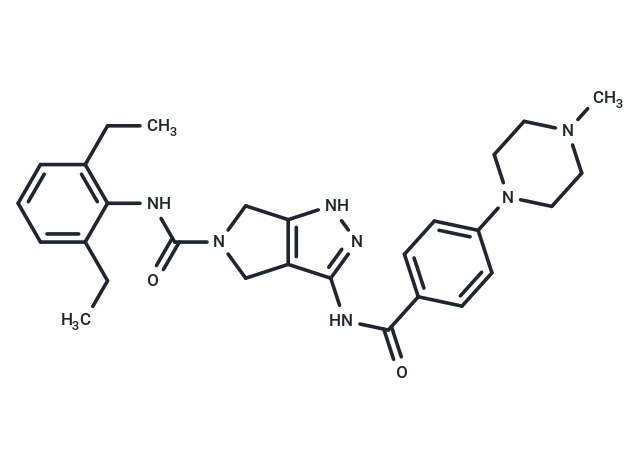Shopping Cart
- Remove All
 Your shopping cart is currently empty
Your shopping cart is currently empty

PHA-680632 is potent inhibitor of Aurora A, Aurora B and Aurora C with IC50 of 27 nM, 135 nM and 120 nM, respectively. It has 10- to 200-fold higher IC50 for FGFR1, FLT3, LCK, PLK1, STLK2, and VEGFR2/3.

| Pack Size | Price | Availability | Quantity |
|---|---|---|---|
| 5 mg | $39 | In Stock | |
| 10 mg | $72 | In Stock | |
| 25 mg | $147 | In Stock | |
| 50 mg | $255 | In Stock | |
| 100 mg | $427 | In Stock | |
| 1 mL x 10 mM (in DMSO) | $43 | In Stock |
| Description | PHA-680632 is potent inhibitor of Aurora A, Aurora B and Aurora C with IC50 of 27 nM, 135 nM and 120 nM, respectively. It has 10- to 200-fold higher IC50 for FGFR1, FLT3, LCK, PLK1, STLK2, and VEGFR2/3. |
| Targets&IC50 | Aurora A:27 nM, Aurora B:135 nM, Aurora C:120 nM |
| In vitro | PHA-680632 potently inhibits all three Aurora kinases (A, B, and C) with IC50 values of 27, 135, and 120 nM, respectively. PHA-680632 is selective for Aurora kinases, with 10- to 200-fold higher IC50 for FGFR1, FLT3, LCK, PLK1, STLK2, VEGFR2, and VEGFR3, and with IC50 higher than 10 μM for another 22 kinases. PHA-680632 shows potent anti-proliferative effects in a wide range of cell types with IC50 values of 0.06–7.15 μM, including HeLa, HCT116, HT29, LOVO, DU145, and NHDF cells. PHA-680632 (0.5 μM) causes polyploidy in tumor cells. The mechanism of action of PHA-680632 is in agreement with inhibition of Aurora kinases. [1] PHA680632 in association with radiation leads to additive effects in cancer cells, especially in the p53-deficient cells. Combined ionising radiation (IR) and treatment of PHA680632 (100–400 nM) prior to IR leads to an enhancement of radiation-induced Annexin V positive cells, micronuclei formation, and Brca1 foci formation only in HCT116 cells with deficient p53, other than the p53 wild-type counterparts. [2] |
| In vivo | HA-680632 (15–60 mg/kg) inhibits tumor growth in mice xenografts models of HL60, A2780, and HCT116 cells, by reducing tumor cell proliferation and increasing apoptosis. PHA-680632 (45 mg/kg) suppresses growth of activated ras-driven mammary tumors in mouse mammary tumor virus v-Ha-ras transgenic mice and results in complete tumor stabilization and partial regression. [1] |
| Kinase Assay | Aurora Kinase Inhibition Assay: Inhibition of kinase activity by PHA-680632 is assessed using a scintillation proximity assay format. The biotinylated substrate is transphosphorylated by the kinase in presence of ATP traced with γ33-ATP. The phosphorylated substrate is then captured using streptavidin-coated scintillation proximity assay beads and the extent of phosphorylation is evaluated by β-counter after a 4-hour rest for the floatation of the beads on a dense 5 M CsCl solution. In particular, a peptide derived from the Chocktide sequence (LRRWSLGL) is used as substrate for Aurora A, whereas the optimized peptide Auroratide is employed for Aurora B and C. The assay is run in a robotized format on 96-well plates. The potency of the compound toward Aurora kinases is evaluated and IC50 values are determined. |
| Cell Research | Cells (5 × 103 to 1.5 × 104 per cm2) are seeded in 24-well plate. After 24 hours, plates are treated with PHA-680632 and incubated for 72 hours. At the end of incubation time, cells are detached from each plate and counted using a cell counter. IC50s are calculated using percentage of growth versus untreated cont(Only for Reference) |
| Alias | PHA680632, PHA 680632 |
| Molecular Weight | 501.62 |
| Formula | C28H35N7O2 |
| Cas No. | 398493-79-3 |
| Smiles | CCc1cccc(CC)c1NC(=O)N1Cc2[nH]nc(NC(=O)c3ccc(cc3)N3CCN(C)CC3)c2C1 |
| Relative Density. | 1.294g/cm3 |
| Storage | Powder: -20°C for 3 years | In solvent: -80°C for 1 year | Shipping with blue ice. | |||||||||||||||||||||||||||||||||||
| Solubility Information | Ethanol: < 1 mg/mL (insoluble or slightly soluble) DMSO: 93 mg/mL (185.4 mM), Sonication is recommended. H2O: < 1 mg/mL (insoluble or slightly soluble) | |||||||||||||||||||||||||||||||||||
Solution Preparation Table | ||||||||||||||||||||||||||||||||||||
DMSO
| ||||||||||||||||||||||||||||||||||||

Copyright © 2015-2025 TargetMol Chemicals Inc. All Rights Reserved.